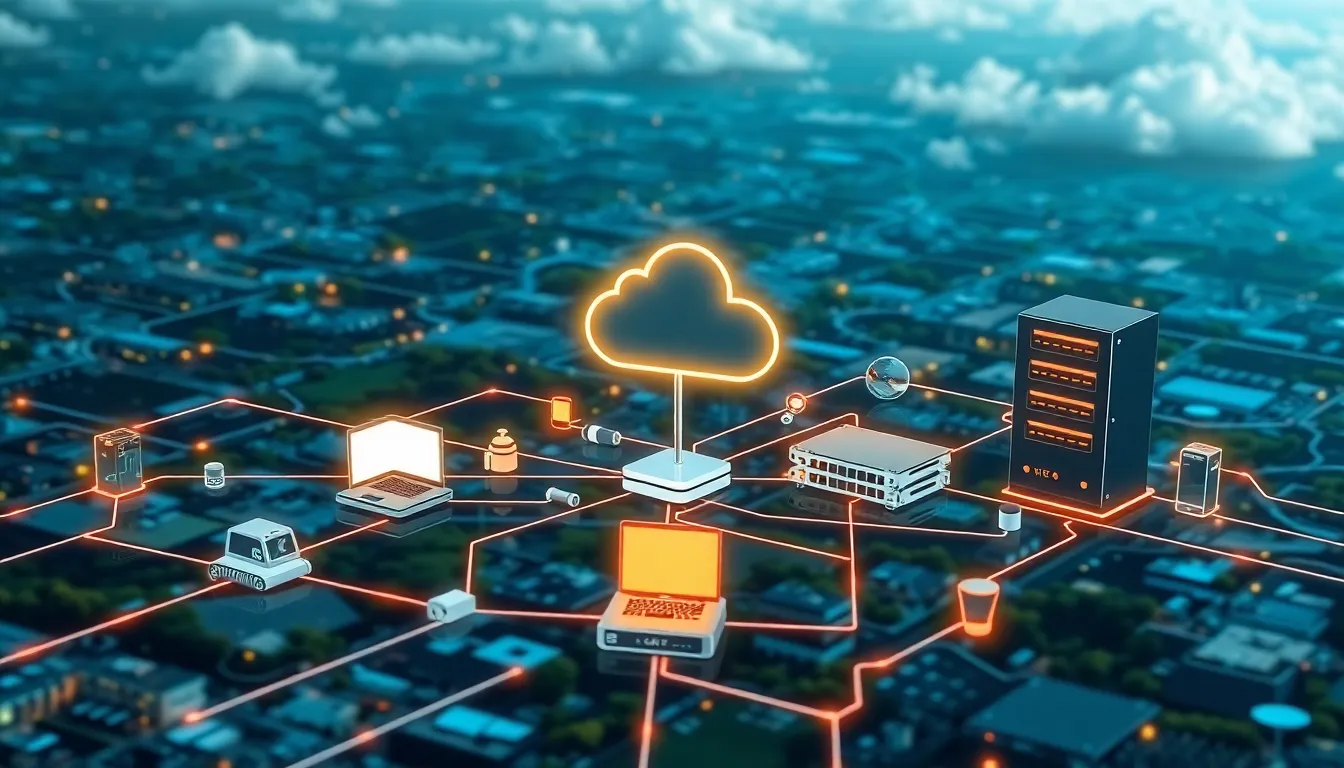In a world where smart devices are multiplying faster than rabbits, managing their demands can feel like juggling flaming torches. Enter IoT load balancing, the unsung hero that ensures everything runs smoothly without turning into a chaotic circus act. It’s the secret sauce that keeps data flowing seamlessly, preventing those dreaded bottlenecks that make even the most patient tech enthusiast want to pull their hair out.
Table of Contents
ToggleUnderstanding IoT Load Balancing
IoT load balancing is vital for optimizing the performance of smart devices. This process ensures efficient distribution of workloads across various devices and systems, allowing seamless data flow and reducing congestion.
What Is IoT Load Balancing?
IoT load balancing refers to the technique of distributing network traffic evenly among multiple devices. This technique helps prevent any single device from becoming overwhelmed with excessive data or requests. Implementing IoT load balancing enables better resource management, enhancing the overall user experience in smart environments. Load balancing algorithms intelligently determine how to allocate tasks based on real-time data, ensuring optimal performance and reliability.
Importance of Load Balancing in IoT
Effective load balancing plays a significant role in the Internet of Things ecosystem. High device density in smart networks leads to enormous data volumes and potential bottlenecks. By distributing workloads, IoT load balancing enhances system reliability and minimizes the risk of service interruptions. Furthermore, it facilitates better scalability, allowing systems to accommodate a growing number of devices without compromising performance. As a result, organizations benefit from improved responsiveness and lower operational costs.
Key Concepts in IoT Load Balancing

IoT load balancing focuses on distributing workloads effectively across multiple devices to optimize performance and reliability. Several key concepts form the foundation of this essential technique.
Load Balancing Algorithms
Load balancing algorithms play a crucial role in determining how workloads are distributed. Popular algorithms include round-robin, least connections, and IP hash. Round-robin assigns requests to servers sequentially, ensuring equal distribution. The least connections algorithm routes traffic to the server with the fewest active connections, improving efficiency. IP hash directs requests based on the client’s IP address, ensuring consistent routing. Each algorithm offers distinct benefits based on user requirements and network conditions.
Types of Load Balancing Techniques
Various load balancing techniques enhance the management and performance of IoT systems. Hardware-based load balancing employs dedicated devices to manage traffic, enhancing speed and reliability. Software-based load balancing utilizes algorithms to efficiently distribute workloads across application servers, offering flexibility and scalability. Cloud-based load balancing provides elasticity, enabling dynamic resource allocation based on traffic demands. Each technique adapts to different environments, ensuring optimal performance in diverse IoT ecosystems.
Challenges in IoT Load Balancing
IoT load balancing faces several challenges that can impede performance and efficiency. Understanding these obstacles helps in developing effective strategies to mitigate them.
Scalability Issues
Scalability remains a significant challenge in IoT load balancing. As device numbers rise, managing increased data traffic becomes complex. Insufficient scalability leads to overloaded systems that struggle to accommodate new devices or workloads. Adapting infrastructure is essential to handle fluctuations in demand. Some organizations find that their existing solutions don’t scale effectively, resulting in performance drops. To manage this, implementing elastic load balancing solutions can enhance adaptability as traffic levels change.
Network Latency
Network latency presents another major challenge in IoT load balancing. Latency affects data transmission speed, leading to delays in communication between devices. Increased latency can disrupt real-time processing, causing negative user experiences. Effective load balancing requires minimizing latency, especially during peak traffic periods. Many systems encounter slowdowns, which can reduce overall efficiency. Utilizing edge computing can help reduce the distance data must travel, thus lowering latency and improving responsiveness.
Real-World Applications of IoT Load Balancing
IoT load balancing plays a crucial role across various sectors, ensuring efficient management of connected devices and data flow. Here are two significant applications where its impact is evident.
Smart Cities
Smart cities leverage IoT load balancing to manage interconnected infrastructure effectively. Traffic management systems can distribute data from multiple sensors in real-time, preventing congestion. Public transportation benefits as load balancing optimizes routing and schedules based on real-time data. Energy management systems utilize load balancing to monitor usage patterns across a network of smart meters, distributing energy resources effectively. Public safety systems utilize seamless data flow for quick response times, enabling rapid adjustments to emergency services.
Industrial Automation
In industrial automation, IoT load balancing enhances operational efficiency in manufacturing. Machines communicate data through a balanced network, preventing overloads that can cause delays. Production lines benefit from continuous monitoring and adjustment of workloads, optimizing throughput. Predictive maintenance uses data from various sensors to allocate resources dynamically, minimizing downtime. Additionally, supply chain management improves through balanced data flow, leading to better inventory management and logistics.
Future Trends in IoT Load Balancing
Emerging trends in IoT load balancing reflect a dynamic landscape where technology continuously evolves to meet growing demands. Innovations, particularly in AI and edge computing, will redefine system performance and efficiency.
AI and Machine Learning Integration
AI and machine learning integration transforms IoT load balancing by predicting traffic patterns and optimizing resource usage. These technologies analyze historical data to allocate workloads intelligently, resulting in enhanced responsiveness during peak times. Patterns indicate that machine learning algorithms adjust in real-time, minimizing latency and increasing throughput. Real-time analysis transforms the decision-making process, allowing for proactive adjustments rather than reactive ones. This results in superior performance and improved user experiences across connected devices.
Edge Computing Solutions
Edge computing solutions are gaining traction for their potential to enhance IoT load balancing capabilities. By processing data closer to the devices, edge computing reduces latency and bandwidth usage, optimizing data flow. Localized processing also alleviates strain on centralized servers, distributing workloads effectively. Efficient data management leads to faster response times, critical for applications like autonomous vehicles and smart grids. Businesses benefit from improved reliability and reduced operational costs, making edge computing a pivotal element in future IoT architectures.
IoT load balancing stands as a critical component in the management of smart devices and their data flows. By effectively distributing workloads, it ensures that no single device becomes overwhelmed, leading to improved performance and user satisfaction. As organizations continue to adopt IoT solutions, the ability to adapt to fluctuating demands and minimize latency will be essential.
Emerging technologies like AI and edge computing are set to further enhance load balancing strategies, paving the way for smarter and more efficient systems. The future of IoT hinges on these innovations, allowing for seamless integration and management of interconnected devices in various sectors. Embracing these advancements will not only optimize operations but also unlock new possibilities in the ever-evolving landscape of IoT.





